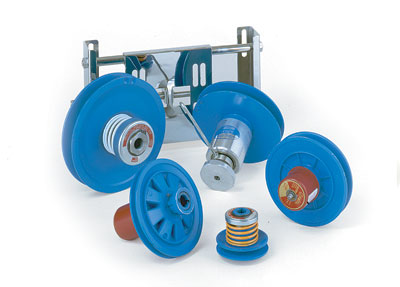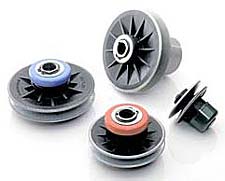Product Description
variable speed pulley ,V pulley, V belt pulley, V groove pulley, V groove belt pulley, taper lock pulley, taper lock V belt pulley, taper lock bushing pulley, taper lock pulleys / taper bore pulley, large V belt pulley, double V belt pulley, cast iron V belt pulley belt pulley, variable speed V belt pulleys, V belt pulley split pulley, cast iron V belt pulley
V belt pulley specifications:
1) European standard:
A) V-belt pulleys for taper bushings: SPZ, SPA, SPB, SPC; Up to 10 grooves
B) Adjustable speed V-belt pulleys and variable speed pulleys
C) Flat belt pulleys and conveyor belt pulleys
2) American standard:
A) Sheaves for taper bushings: 3V, 5V, 8V
B) Sheaves for QD bushings: 3V, 5V, 8V
C) Sheaves for split taper bushings: 3V, 5V, 8V
D) Sheaves for 3L, 4L or A, and 5L or B belts: AK, AKH, 2AK, 2AKH, BK, BKH, 2BK, 2BKH, 3BK
E) Adjustable sheaves: Poly V-pulley, multi-pitch H, L, J, K and M
3) Bore: Pilot bore, finished bore, taper bore, bore for QD bushing
4) Surface finish: Paint, phosphating, zinc plated
5) Material: Cast iron, ductile iron, nylon, aluminum
6) Made according to drawings and/or samples, OEM inquiries welcomed
|
|
Specification: |
| 1 | Made of superior cast iron; Pulley type: V Pulley; |
| 2 | Good hardness and strength. Anticorrosive capability; |
| 3 | SPA, SPB, SPC, SPZ, AK, AKH, 2AK, 2AKH, BK, BKH,2BK, 2BKH, 3BK and non-standard series; |
| 4 | All the products would be done by precise machining and power painting to get smooth surface; |
| 5 | Every product would be tested repeatedly and carefully before the shipment; |
| 6 | Safe package to protect products during the shipment; |
| Advantages: | |
| 1 | The strong technology group as well as the advanced equipment; |
| 2 | More than 20 years experience; |
| 3 | The Products have got good comments in the world market; |
| 4 | OEM service and special design service be accepted; |
| 5 | ISO9001-2000 Certified. |
| Material: | Cast Iron |
|---|---|
| Application: | Industry |
| Toothed Portion Shape: | Spur Gear |
| Type: | Circular Gear |
| Changes Way: | Stepped |
| Manipulate Way: | Forced Manipulation |
| Customization: |
Available
| Customized Request |
|---|

How do you select the right variable pulley configuration for a specific task?
Selecting the right variable pulley configuration for a specific task involves considering several factors. Here are the key steps in the selection process:
1. Define the Requirements:
Start by clearly defining the requirements of the task or application. Determine the desired speed range, torque, power transmission capacity, and any specific control requirements.
2. Evaluate Speed Variation:
Assess the required speed variation range. Consider whether a stepless or stepped speed variation is needed and determine the desired number of speed settings.
3. Consider Torque and Power:
Evaluate the torque and power requirements of the task. Calculate the maximum torque and power that the variable pulley configuration needs to handle to ensure reliable and efficient operation.
4. Assess Space and Installation Constraints:
Consider the available space for the variable pulley configuration and any installation constraints. Evaluate the physical dimensions, mounting options, and compatibility with the existing machinery or equipment.
5. Determine Adjustability and Control:
Determine the level of adjustability and control required for the task. Assess whether manual adjustment or automated control is needed, and consider the ease of adjustment and precision required.
6. Evaluate Maintenance and Durability:
Consider the maintenance requirements and durability of the variable pulley configuration. Assess factors such as the expected lifespan, maintenance intervals, and availability of spare parts.
7. Seek Expert Advice:
If necessary, consult with experts or manufacturers who specialize in variable pulley systems. They can provide valuable insights and recommendations based on their expertise and experience.
By carefully evaluating these factors, you can select the right variable pulley configuration that meets the specific requirements of your task or application. It is essential to consider the performance, functionality, and compatibility of the variable pulley system to ensure optimal results and long-term reliability.

How are variable pulleys customized for specific machinery and equipment?
Variable pulleys can be customized to suit specific machinery and equipment requirements. The customization process involves several key aspects to ensure optimal performance and compatibility. Here’s an overview of how variable pulleys are customized:
1. Design Considerations:
The customization of variable pulleys begins with understanding the specific machinery and equipment requirements. Factors such as the desired speed range, torque requirements, power transmission capacity, and space constraints are taken into account. These design considerations help determine the appropriate size, shape, and configuration of the variable pulley to ensure it fits seamlessly into the target system.
2. Speed Range and Ratios:
Variable pulleys can be customized to provide the desired speed range and speed ratios for the machinery. By selecting the appropriate combination of fixed and movable pulley halves, the speed range can be tailored to meet the specific operational needs. This customization ensures that the variable pulley can achieve the required speed control and variability for the machinery.
3. Load Capacity:
The load capacity of the machinery is a critical consideration in variable pulley customization. The design and materials used in the pulley construction need to be selected to handle the expected loads and torque requirements. This customization ensures that the variable pulley can effectively transmit power and withstand the forces generated during operation.
4. Belt or Chain Compatibility:
Variable pulleys are often used in conjunction with belts or chains for power transmission. Customization involves ensuring compatibility between the variable pulley and the specific belt or chain type used in the machinery. Factors such as belt width, pitch, and tooth profile are considered to ensure proper engagement, grip, and power transmission efficiency.
5. Mounting and Integration:
Customization of variable pulleys involves designing the appropriate mounting and integration features. This ensures that the pulley can be easily and securely mounted within the machinery or equipment. Mounting options may include keyways, set screws, clamping mechanisms, or other fastening methods, depending on the specific application requirements.
6. Material Selection:
The choice of materials for the variable pulley is an essential customization consideration. Factors such as durability, corrosion resistance, and weight are taken into account. Common materials used for variable pulleys include steel, aluminum, and various alloys. The material selection is based on the specific application requirements and environmental conditions in which the machinery operates.
7. Performance Testing and Validation:
Once the variable pulley is customized, it undergoes rigorous performance testing and validation. This ensures that it meets the specified speed control, load capacity, and durability requirements for the machinery. Performance testing may involve simulated operating conditions, torque and speed measurements, and endurance testing to ensure reliable and consistent performance.
By considering design requirements, speed range, load capacity, belt or chain compatibility, mounting and integration, material selection, and performance testing, variable pulleys can be effectively customized for specific machinery and equipment. This customization process ensures that the variable pulleys meet the unique performance and operational needs of the target applications.

What is a variable pulley, and how does it function in mechanical systems?
A variable pulley, also known as a variable speed pulley or a variable drive pulley, is a type of pulley designed to provide variable speed ratios in mechanical systems. It consists of two or more pulley halves that can move relative to each other, allowing for adjustment of the effective diameter and thus changing the speed ratio between the input and output shafts.
The primary function of a variable pulley is to provide a means of continuously adjusting the speed of driven components in a mechanical system without the need for manual gear changes or transmission adjustments. This flexibility is particularly useful in applications where speed variations are required to accommodate different load conditions or to achieve specific operational requirements.
The operation of a variable pulley is based on the principle of changing the effective diameter that the belt or chain engages with. It typically consists of a fixed pulley half and a movable pulley half, both connected by a belt or chain. The movable pulley half is designed to slide or pivot, which changes the distance between the pulley halves, thus altering the effective diameter.
When the movable pulley half is positioned closer to the fixed pulley half, the effective diameter increases. This results in a larger belt or chain contact area and a higher speed ratio between the input and output shafts. Conversely, when the movable pulley half is positioned farther away, the effective diameter decreases, leading to a smaller contact area and a lower speed ratio.
Variable pulleys can be actuated by different mechanisms, such as hydraulic, pneumatic, or mechanical means. The actuation mechanism allows for precise adjustment of the movable pulley position, enabling smooth speed transitions and accurate control.
One common application of variable pulleys is in automotive vehicles, where they are used in continuously variable transmissions (CVTs). In a CVT, the variable pulleys provide seamless speed adjustments, allowing the engine to operate at its optimal speed for different driving conditions, resulting in improved fuel efficiency and performance.
In summary, a variable pulley is a pulley system that enables continuous adjustment of speed ratios in mechanical systems. By changing the effective diameter through the movement of pulley halves, it allows for variable speed control without the need for manual gear changes. Variable pulleys find applications in various industries, providing flexibility, efficiency, and precise speed control in mechanical systems.


editor by CX
2023-09-23
